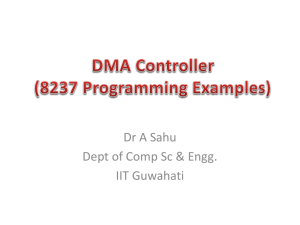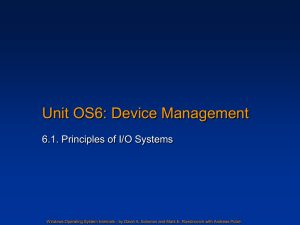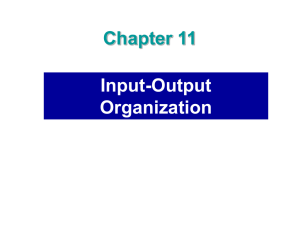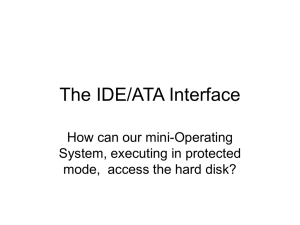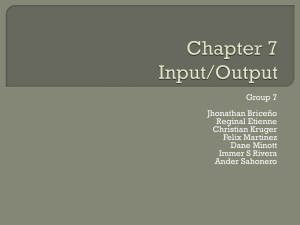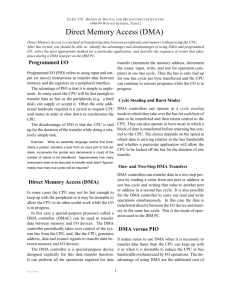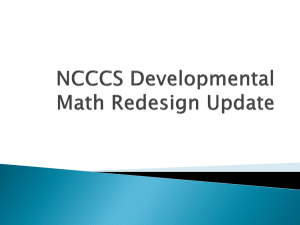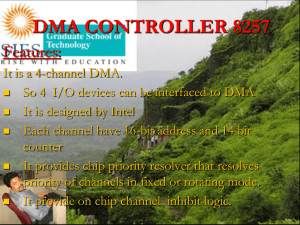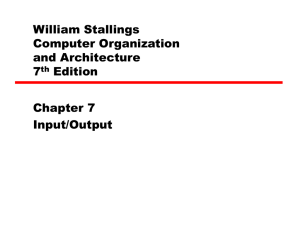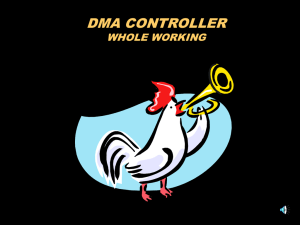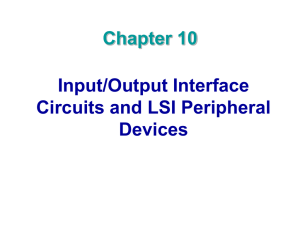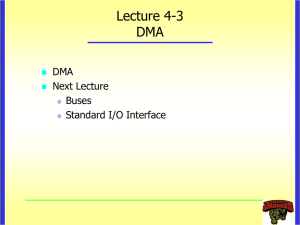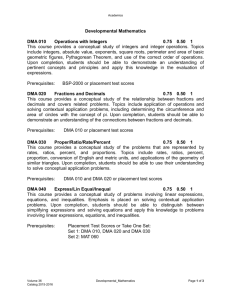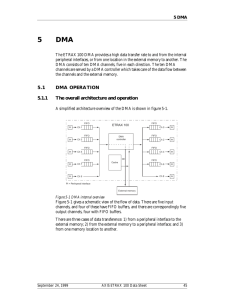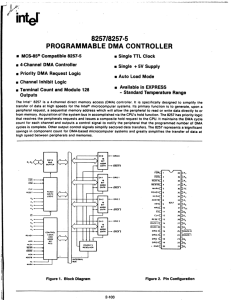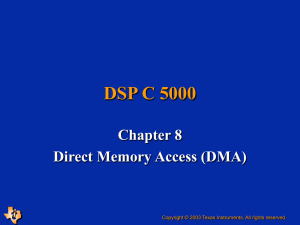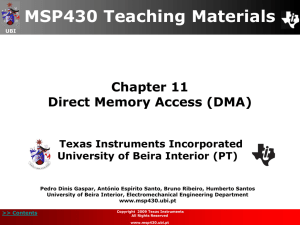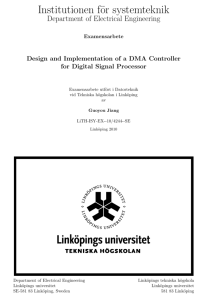PPTX Slides
advertisement
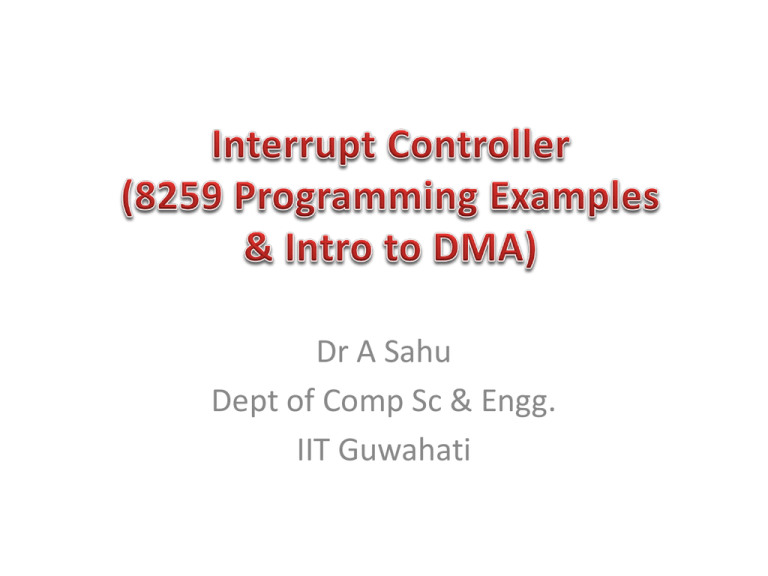
Dr A Sahu Dept of Comp Sc & Engg. IIT Guwahati • • • • • • 8259 Control and Operation word 8259 programming and interrupts Nested Interrupts DMA controller DMA Architecture Introduction to Programming DMA (Next class) • Next class will be in Room 1201 IRQ0 8 bit Data Bus RDb WRb CSb A0 INT INTAb IRQ1 8259A Programmable Interrupt Controller IRQ2 IRQ3 IRQ4 IRQ5 IRQ6 IRQ7 SPb/ENb INTAb INT Control Logic Interrupt Service Register Priority Resolver Interrupt Mask Register Internal Bus Interrupt Request Register IRQ0 IRQ1 IRQ2 IRQ3 IRQ4 IRQ5 IRQ6 IRQ7 03FF 03FE 03FD 03FC IP High Byte CS Low Byte IP High Byte IP Low byte 0007 0006 0005 0004 0003 0002 0001 0000 IP High Byte CS Low Byte IP High Byte IP Low byte IP High Byte CS Low Byte IP High Byte IP Low byte Memory in Hex int type 255 Int type 0 Int type 1 • Fully Nested Modes – IR are arranged in IR0-IR7 and Any IR can be assigned Highest or lowest priority IR4=0 (high), IR3=7 (low) • Automatics Rotation Mode – A device after being served, receive the lowest priority with value 7 0123456712345670 23456701 • Specific Rotation Mode – User can select any IR for lowest priority 0673451267345120 73451206 • EOI: End of interrupt – Specific EOI Command – Automatic EOI: no command necessary – Non-Specific EOI: it reset the ISR bit CS A0 Initialization 0 0 ICW1 0 1 ICW2,ICW3,ICW4 1 X Not Address AD0 D7 D6 D5 D4 D3 D2 D1 D0 0 0 0 0 1 LTIM 0 SGNL IC4 0 for x86 1 for Level Trigger 0 for Edge Trigger 1=single 0=Cascade AD0 D7 D6 D5 D4 D3 D2 D1 D0 1 T7 T6 T5 T4 T3 T2 T1 T0 T7=T0 is the assign to IR0, Vector address for ISR • OCW (operation command word) CS A0 Operation Command Word 0 0 OCW1 0 1 OCW2,OCW3,OCW4 1 X Not Address AD0 D7 D6 D5 D4 D3 D2 D1 D0 1 M7 M6 M5 M4 M3 M2 M1 M0 Interrupt Masks: 1= Mask Set, 0 =Mask reset AD0 D7 D6 D5 D4 D3 D2 D1 D0 0 R SL EOI 0 0 L2 L1 L0 Rote Speci ate fic EOI IR Level to be acted Upon (0-7) A7 A6 A5 IR0 IR1 E1b E2b E3 A3 A2 A1 IR2 A2 3-to-8 0 4 A1 Decoder A0 CSb A0 8259 Emergency A/D converter Keyboard A0 IR6 ADDRESS= 80H, 81H Printer AD0 D7 D6 D5 1 M7= 0 M6= 1 M5= 1 D4 D3 D2 D1 D0 M4= M3= M2= M1= M0= 1 1 1 1 1 Interrupt Masks: 1= Mask Set, 0 =Mask reset OCW1=7F AD0 D7 D6 D5 D4 D3 D2 D1 D0 0 0 1 1 1 0 1 1 0 0 for Edge Trigger Call Address interval =4 1=single 0=Cascade A7, A6,A5 Lower address bit of Vector Address AD0 D7 D6 D5 D4 D3 D2 D1 D0 1 T7 T6 T5 T4 T3 T2 T1 T0 0 0 1 0 0 0 0 0 T7=T0 is the assign to IR0, Vector address for ISR Lower Byte of call address Vector Address 2060, 2064…. 0100 0000 0 1 1 00000 76H 20H DI MVI OUT MVI OUT A, 76H 80H A, 20H 81H ;move ICW1 byte to ACC ; initialize 8259A ICW1 ; mov ICW2 byte to ACC ; Initialize 8259A ICW2 MVI OUT A, 7FH 80H ; Put the OCW1 • By Default 8259 work in Nested modes – Unless we put a different OCW • Suppose IR2 has highest priority and IR6 • IR6 is being serviced • IR2 can be nested iff IR6 IRS issue an EI command • Address of IR2=2068, IR2=2074 EI Interrupt at IR6 It wait up to EI instruction Interrupt at IR2 EI EI DI RET IR2 has highest priority IR6 has lower priority EOI EI RET • Those interrupt service can be temporarily disable to let the higher priority interrupt ISR to be executed un-interruptly • I want IR7 to be Non Maskable AD0 D7 D6 D5 1 M7= 0 M6= 1 M5= 1 D4 D3 D2 D1 D0 M4= M3= M2= M1= M0= 1 1 1 1 1 Interrupt Masks: 1= Mask Set, 0 =Mask reset OCW1=7F • • • • Direct memory access DMA Controller DMA mode of I/O Programmed mode I/O vs DMA mode I/O CPU System Bus System Bus Memory DMA Controller CPU I/O Memory I/O • Programmed I/O – Done by busy-waiting • This process is called polling • Example – Reading a key from the keyboard involves • Waiting for status bit to go low – Indicates that a key is pressed • Reading the key scan code • Translating it to the ASCII value • Waiting until the key is released • Problems with programmed I/O – Processor wastes time polling – Lets take example of Key board • Waiting for a key to be pressed, • Waiting for it to be released • May not satisfy timing constraints associated with some devices : Disk read or write • DMA – Frees the processor of the data transfer responsibility Interrupt Controller IREQ INTR HOLD CPU HOLDA DMA Controller DREQ DACK IORDb IOWRb EOPb I/O Controller MEMRDb MEMWRb Memory Data Bus Address Bus • DMA is implemented using a DMA controller • DMA controller – Acts as slave to processor – Receives instructions from processor – Example: Reading from an I/O device • Processor gives details to the DMA controller • I/O device number • Main memory buffer address • Number of bytes to transfer • Direction of transfer (memory I/O device, or vice versa) • HOLD: DMA to CPU – DMA Send HOLD High to CPU – I (DMA) want BUS Cycles • HOLDA – CPU send HOLDA – BUS is granted to DMA to do the transfer – DMA is from Slaves to Master mode • HOLD Low to CPU – I (DMA) finished the transfer • Cycle Stealing if One BUS • Other wise Separate process independent of processing • Processor initiates the DMA controller – Gives device number, memory buffer pointer, … Called channel initialization – Once initialized, it is ready for data transfer • When ready, I/O device informs the DMA controller – DMA controller starts the data transfer process » Obtains bus by going through bus arbitration » Places memory address and appropriate control signals » Completes transfer and releases the bus » Updates memory address and count value » If more to read, loops back to repeat the process • Notify the processor when done – Typically uses an interrupt • 8237 supports four DMA channels • It has the following internal registers – Current address register • One 16-bit register for each channel • Holds address for the current DMA transfer – Current word register • Keeps the byte count • Generates terminal count (TC) signal when the count goes from zero to FFFFH – Command register • Used to program 8257 (type of priority, …) – Mode register • Each channel can be programmed to – Read or write – Auto increment or auto decrement the address – Auto initialize the channel – Request register • For software-initiated DMA – Mask register • Used to disable a specific channel – Status register – Temporary register • Used for memory-to-memory transfers • Single cycle transfer – Only single transfer takes place – Useful for slow devices • Block transfer mode – Transfers data until TC is generated or external EOPb signal is received • Demand transfer mode – Similar to the block transfer mode – In addition to TC and EOP, transfer can be terminated by deactivating DREQ signal • Cascade mode – Useful to expand the number channels beyond four • Next Class… • R S Gaonkar, “Microprocessor Architecture”, Chapter 15
